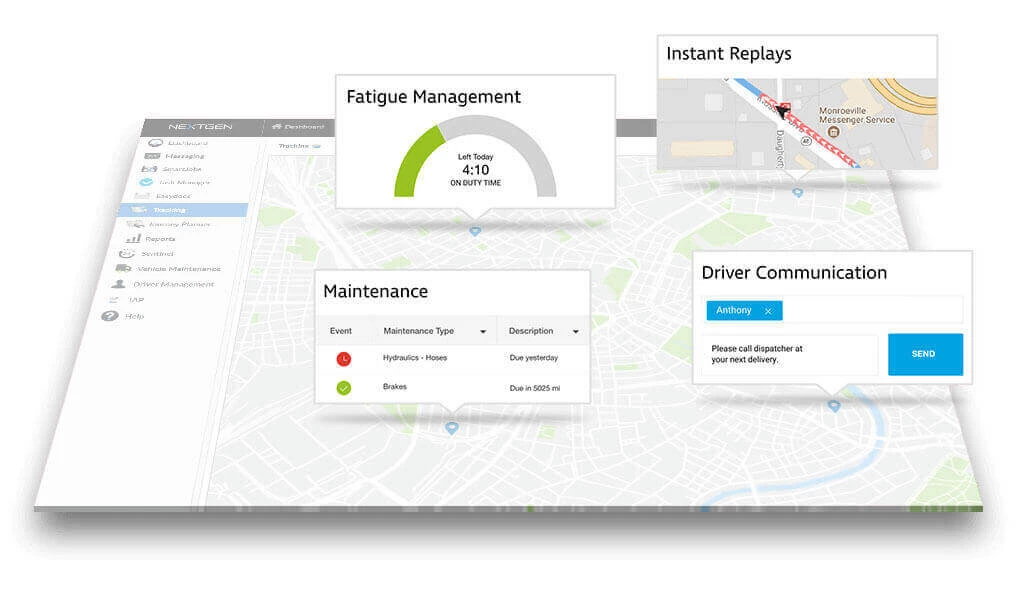

GPS truck tracking is a type of software installed in trucking fleets to maximise fleet visibility for owners and/or managers. It provides critical insights for informed, real-time decisions that increase driver safety, reduce fuel costs, simplify maintenance planning, streamline vehicle routing and enable fleet operations to be more flexible in meeting customer needs.
Reliant on GPS truck trackers and telematics technology, truck tracking systems complete a range of functions by collecting vehicle location and activity data, typically using a combination of sensors, hard-wired engine diagnostics and GPS enabled devices. The data collected through secure cellular networks, is displayed and visualized in a web-based software platform allowing fleet managers and business owners to run reports potentially exposing inefficiencies and make informed business decisions in real-time.
Whether you are saving money on fuel by optimising routes or monitoring driver behaviour to reduce idle time and aggressive driving habits – like speeding or harsh acceleration – GPS truck tracking systems provide the data that enable fleet managers in the business to implement processes that lead to cost savings. With accurate data and instant alerts, senior management can leverage truck tracking systems to coach drivers on unsafe practices and poor driving behaviours that are putting themselves and the business at risk. By improving routes by understanding jobs and localised traffic hotspots, better training staff to understand the real costs to the business, and monitoring idling while on the road, you're able to reduce the rate of fuel used as well as the cost of fuel in the business.
With the analytics provided by the telematics system, drivers are able to understand their poor habits and correct them with audible and visual alerts from their in-cab device. Truck tracking can be used as a behavioural learning system by actively warning drivers when safe driving violations - such a speeding - occur as well as a platform to reward drivers for their improvement. With the data, you can construct personalised training programs to help drivers with their driving habits based on real information. Truck tracking systems can be a tool used to coach high risk drivers and reward your safest. In addition, you're able to further identify underlying trends across that fleet, for example, issues with vehicles rather than the driver.
With precise truck location tracking, the business is able to benefit instantly by providing instant feedback to customer requests - such as knowing how far off a driver is to deliver the customer's package(s), or redirect the nearest drivers to them. By optimising routes to get to customers quicker, and complete more jobs per day, you can reduce delays and improve on customer satisfaction. Telematics can also be used to digitise the job management procesess and provide an electronic means for drivers to complete jobs and capture signatures on screen. This automation provides a higher level of assurance of productivity in the business, allowing the business to be more efficient for the customer as jobs can be booked electronically rather than tracking down details or drivers manually.
Fleet management systems that provide truck tracking functionality operate via secure means, ensuring that data is safe and only accessible to those with correct access. Beyond data security, is the security of your assets. Alerts can be created to trigger when a vehicle or asset is used outside specific times (such as after 5pm), or outside of specific sites (via geofences) to help recover the assets quicker and notify authorities instantly. To a business, this means that the operation can back to normal quicker, rather than having to purchase or hire assets that were stolen.
With telematics and truck tracking, you are able to get proactive with maintenance. Schedules and alerts allow you to know when vehicles are due for routine maintenance (based on time/date, odometer value or engine hours). When paired with electronic checklists, unexpected maintenance can be reduced or resolved quicker. Maintenance staff are able to flag the vehicle before it leaves the yard or order parts in time for when the vehicle returns to the yard. Proper maintenance schedules ensure fleet compliance with safety regulations and can assist in lower repair cost over time as well as increasing your vehicle’s life cycle. Electronic driver vehicle inspection alerts can often by incorporated in trucking tracking systems allowing business to ensure vehicles are fit for purpose, that pre-trip compliance is adhered to and any defects are dealt with in a timely manner.
Receive daily, weekly or monthly activity logs to see exactly where your vehicles and mobile assets are spending most of their time. This continues to ensure you and everyone in the transport chain are managing risk, helps ensure compliance is monitored and audited, along with verifying drivers are adhering to regulations and can help to ensure everyone in your supply chain are following the procedures. Through activity reporting and real-time analytics that truck tracking can provide, the business is best prepared for issues that arise, will managing risk proactively to reduce occurances.
Traditionally, routes for a driver a typically followed on paper maps, or generally based on runs completed historically. Online tools like Google Maps has gone to help provide a means to verify locations and give drivers a general path to follow, the need for a thorough solution that takes on board the vehicle as well as the roads is important. This is the case for those transporting hazardous or dangerous materials, or completing contracts with specific requirements. These tools can be used to take on board things like size, weight and load to provide the business with a means to better serve their customers while staying to the correct and optimal roads.
Everyone in the transport and supply chain is liable. The need to manage risk is important. With GPS truck tracking capabilities, you can provide an increased level of assurance, from fatigue and speed to mass and maintenance. The integrated system is able to help drivers stay aware of their requirements, give instant feedback to help manage their compliance in real-time and give the business a means to electronically capture compliance data to reduce the workload required to complete audits and fulfill regulations and their requirements. Using the in-cab device, the driver is easily able to follow fatigue requirements with their data broken down to the second to help them understand their position, will giving them real-time speed information, help them record vehicle maintenance faults in real-time, and more.
 12%
12%
Reduced Maintenance
 30%
30%
Reduced Fuel Consumption
 20%
20%
Reduced Incidents & Violations
Whether it’s dangerous driving, fatigue or route changes, a real-time alert feature in truck tracking systems gives you the ability to notify a driver of important changes instantly. Monitor driver behaviour, promote safe driving, easily identify possible fatigue violations, and notify drivers of route updates with instant alerts.
With an Electronic Driver Logbooks (EDLs) managing fatigue, the business is able to manage compliance in real-time while allowing the driver to get on with the job in a digital environment. The driver gets a full breakdown of their events, lets them know their available driver hours, proactively alerts them to take a rest break, and more.
With the ability to get information immediately via a fleet management platform, the ability to create reports and audit information is at the click of the finger. Ensure uptime, keep up with driver fatigue, and maximise productivity. With analytics in real-time, fleet managers are able to monitor the business as the business is happening, not after the fact.
Automate the road user charges process within the business. By complying with all NZTA standards and accepted for use in eRUC purchasing and off-road travel refunds, put money back into your business, saving you valuable time and administration effort while minimising compliance risk.
Have full visibility across your fleet and know where all vehicles are, at all times. Knowing vehicle location helps with job assignment, keeping your customers up to date and driver protection. Vehicle location is often used alongside other activities that enable the business to identify the point of in-efficiency in their workflows, one great example is measuring wait time at customer depots.
Ensuring drivers are in the right places at the right time is critical to working more efficiently. Managers using truck tracking systems are able to apply geofences – or digital borders – around any areas they choose and can set alerts or timestamps indicating when a vehicle enters, or leaves said area. This allows managers to expose key areas where their vehicles are taking longer than expected.
Making sure your vehicles are operating at peak performance is the best way to eliminate unexpected maintenance issues and keep your vehicles on the road. Truck tracking systems allow you to digitally schedule manufacturer-recommended service so you can deploy your trucks with confidence that they are fit for the road, based on date/time, odometer reading or engine hours.
Learn the complete story of where and for how long your vehicles are spending time and see key activity alerts for events such as engine idling, unauthorised vehicle use and drivers being at risk of compliance. Truck tracking systems also capture data from other vehicle sensors, enabling businesses to better understand processes and identify unusual behaviour. Sensors can measure a huge range of activities including pumps being activated, or doors being opened.
Monitoring all vehicle activity is critical when assessing workflow efficiency and fleet safety. Truck tracking systems integrated with IoT sensors can identify unusual vehicle behaviour, this can include doors opening and closing, hydraulic pumps turned on, lifts activated, seatbelts being used, lights out and/or tire pressure being low and more.

Monitor the exact location of all your assets, personnel, and various equipment. Be sure to ask how accurate – and how often - the truck tracking provider’s location tracking is updated. The ability to accurately locate assets in real-time allows trucking fleet operators to monitor more than just location. Pinpoint location data can lead to informed decisions that ultimately can minimise fuel costs, improve productivity, predict maintenance repairs and understand time on site.
When purchasing truck tracking software it is important to find a partner that will support your efforts to optimise fleet performance. Not all GPS truck tracking providers offer the same customer services. How can they assist? Are there services available on demand? What kind of support is available? Look for a provider that can offer customer support teams and professional services staff. A good software provider has role-based support and training services so that your drivers or administrators are getting help from someone who knows the ins and outs of their roles specifically.
Whether you need a plug-and-play device to begin tracking your trucks instantly or a tamper-resistant, commercial-grade hard-wired device that is professionally installed on your schedule, a truck tracking system provider should understand that you need to keep your fleet moving and make the installation process work wherever your trucks are.
Truck tracking can track a variety of medium-to-heavy-duty assets, buses, cargo vans, specialty trucks for dumping and cementing and much more.
Technically GPS truck tracking devices can be installed almost anywhere on a vehicle. When hardwired into the vehicle, it ensures that it cannot be tampered with, ensures operation through rough environments at all times and can be used and available at all times.
To gain a full understanding of how your driver and vehicles are operating truck tracking collects data points such as location tracking, ignition cycles, driver behaviour data such as harsh braking, harsh acceleration and speeding, number of jobs dispatched, proof-of-delivery, maintenance requirements hours of service data and more. Collecting the data provides better insight to driver safety, fuel costs, schedule maintenance, routing and customer requests and productivity.
GPS truck tracking technology is able to pinpoint the location of a vehicle or asset within six feet.
Vehicle movement is tracked in real-time then users select the frequency of how often vehicle location is logged in their truck tracking system. Some systems store HD data when critical events take place that show second-by-second location and driver activity to help understand why the incident took place.